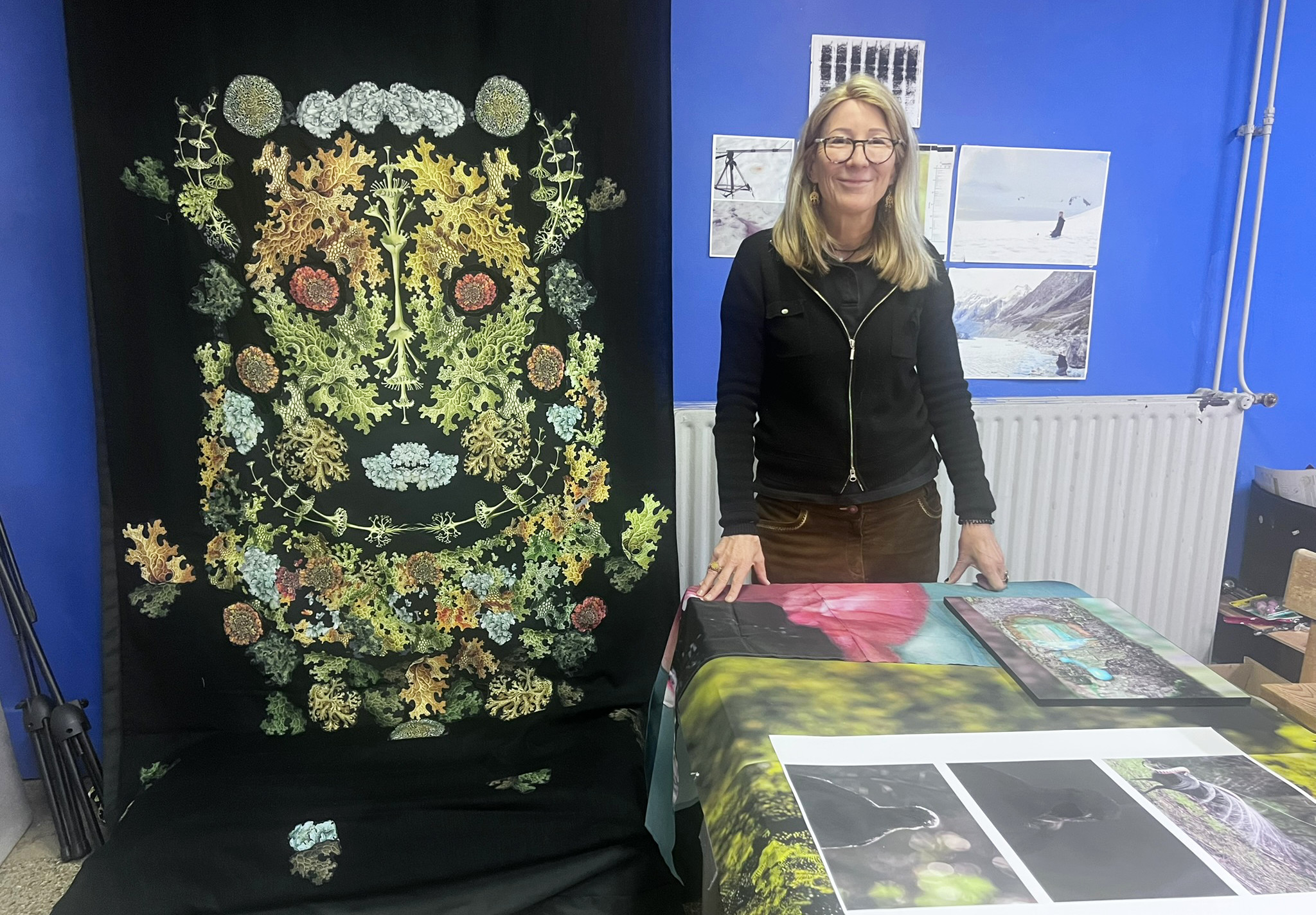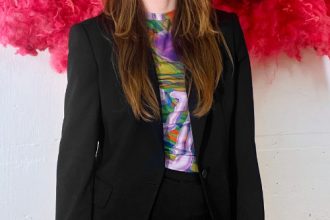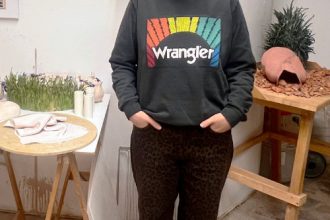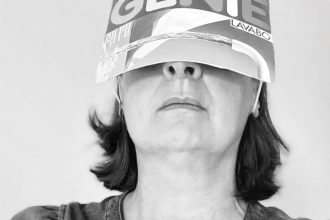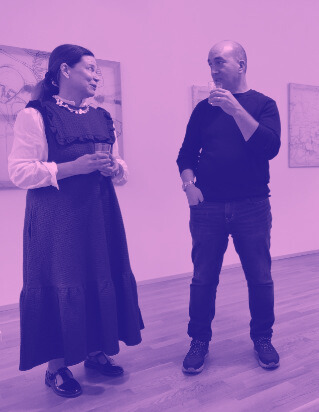In the Studio with Penelope Cain
I met Penelope under the glass-roofed central station of The Hague, the third largest city in Netherlands. We picked up her bike and walked together to her studio. She blended seamlessly with the city’s dynamism and spoke with that flair of bikers who almost never use public transportation. Her energy and vibrancy, set against the black, grey skies of The Hague, disarmed me. Not long ago, she moved to the Hague from Australia with her family. “Netherlands offers far more opportunities,” she told me. “There is far more climate awareness here than in America, Australia, or even Britain creating a space for artists and cultural institutions to engage in climate and environmental conversations. This allows the community to become more understanding of and interested in these issues,” she added.
Indeed, since her move to The Hague in 2022 to participate in S+T+ARTS Residency funded by the European Union, followed by a series of curated events, including an exhibition at Radius CCE in Delft in 2023, Penelope’s works have been in constant dialogue with audiences. In 2024, she exhibited at IMAL in Brussels, Platformpost in Nijmegen, Post Office Projects in Adelaide and OnCurating Project Space in Zurich. She was also selected as an artist-in-residence at Waag, Futurelab under co-direction from Ars Electronica to explore radical care and AI robotics in greenhouses, focusing on the thousands of years old relationship between plants and humans.
Penelope is a planetary storyteller. She tells the stories of the Anthropocene through her artistic productions that are driven by science and research. The term “Anthropocene,” a relatively new word for Earth’s age, has been in use since the early 2000s. It was proposed by the Dutch chemist and Nobel laureate, Paul Crutzen, and the biologist, Eugene Stoermer. The term points out the beginning of a new geological era defined by the impacts of human activities on Earth’s ecosystems.
“It is quite clear that the Holocene has ended, and I like that idea because Holocene was developed to explain a climate that was settled, that did not move much and remained constant,” says Penelope. “On the other hand, Anthropocene has these issues around it, from extraction to capitalism to colonialism,” she continues. “The science community itself is unclear when the Anthropocene began, but the important point we must not miss is that the constant days of a constant climate are over. The big picture is this: the climate is changing.”
Decentering the humancentric gaze is really just a provocation in itself for humans to think about other ways of looking at the world and experience knowledge.
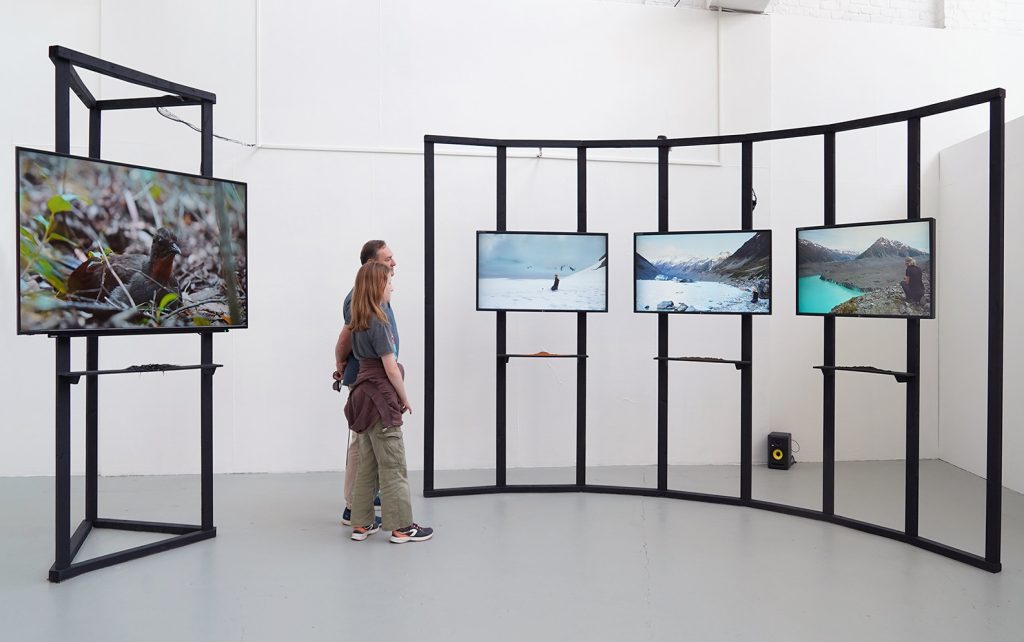
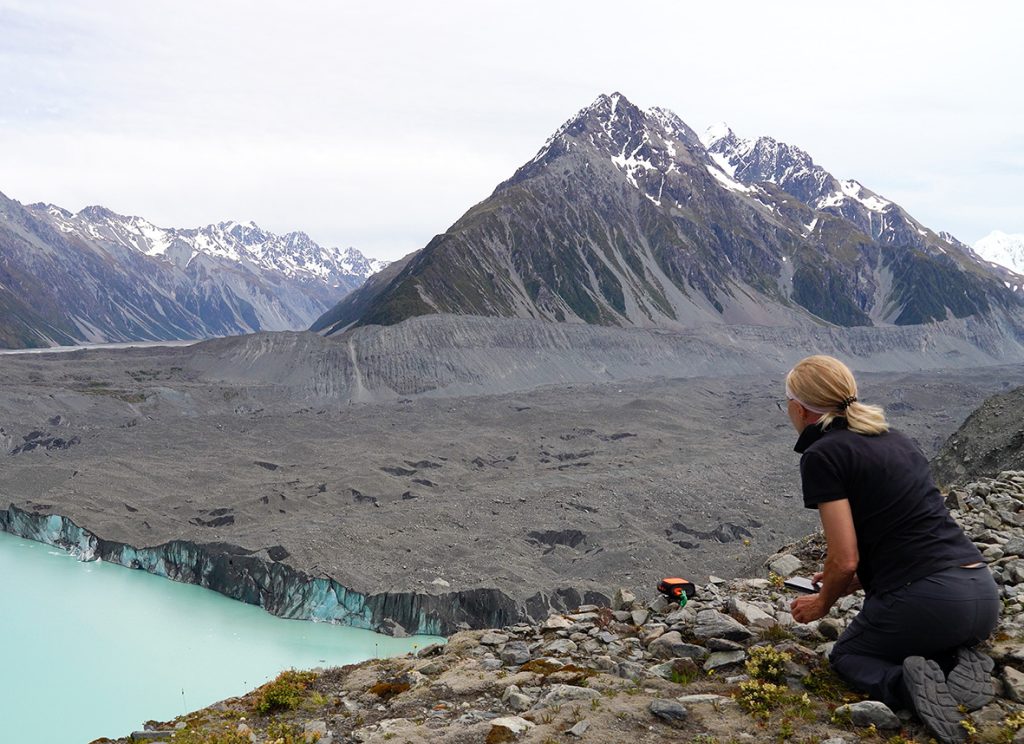
Penelope’s expanded stories are centered around the landscapes of the planet. She is interested in the concept of the landscape beyond its spatial and art historical interpretations. She explores landscapes along their non-human inhabitants and ecosystems as a cultural construction that bears the marks of humans. “Decentering the humancentric gaze is really just a provocation in itself for humans to think about other ways of looking at the world and experience knowledge,” says Penelope. “Of course, you are still making artworks for humans, but this approach allows for asking questions and exploring new ways of thinking from a non-human perspective,” she continues.
In her 2024 work, Songs of Lyrebirds Sung to Glaciers, exhibited as a semi-circular, four-screen video installation made out of wood, Penelope connects the landscapes of New South Wales, Australia, to the glaciers of New Zealand through the memories of the magnificent lyrebirds. These intelligent, long-lived birds are renowned for their exceptional sound-making and dancing abilities. They can imitate any sound they hear, using this skill for courtship and territorial defense. During the 2019-2020 bushfires in Australia, it was estimated that 50% of the lyrebird population was lost, along with the destruction of over 12 million hectares of forest and the death of over 1 billion animals. Penelope came across lyrebirds while filming in the Blue Mountains National Park, documenting the landscape and post fire recovery for her 12-month-long interdisciplinary project, Words for New Landscapes. “After the fires, the forests were silent for the first two to three months but slowly birdlife began to return as the trees grew” explains Penelope. During this time, she became interested in the proposition of lyrebirds as the sonic historians of the forest wondering if they had site specific sonic recollection of all the other missing avian voices, from the glossy black cockatoo to the regent honeyeater and the gang gang. “The lyrebirds seemed to be recalling the former birdlife of the forest, and also calling the forest forth in an active intervention to regrow and repopulate the deforested land,” says Penelope.
After the fires, the forests were silent for the first two to three months but slowly birdlife began to return as the trees grew.
Ash and dust from the fires in Australia travelled across the Tasman Sea and landed on the Southern Alps of New Zealand known as Kā Tiritiri o te Moana (Mirage of the Ocean) in Māori, covering 90% of the glaciated landscape. Penelope travelled to the glaciers and performed the songs of lyrebirds across the New Zealand Alps while documenting the landscape. She maintained close communication with the climate scientists working in the region, who were documenting the impact of the ash on the New Zealand glaciers. The scientists developed a color swatch reflecting the transformation of the icy landscape as the ashes mixed with soil and dirt altered its hues. Penelope incorporated selected pigments from this swatch into her installation, amplifying its spatial and sculptural qualities. The visual, auditory and sensory elements of the installation converged in a single gaze evoke a profound conversation between two distinct landscapes.
“It is a story told from the perspective of the lyrebirds,” says Penelope. I think about the other protagonists in Penelope’s works. In Dust for Antarctica (2018), the lead dust from Broken Hill mine, Australia—toxic to all living beings—arriving in Antarctica 20 years before the first humans set foot there, connecting the bee population, soil, children, and adults through the atomic imprint of the lead released from the pulverized rocks of the mine. In Sound of Wind Through the Crystalline Forest (2019), Cerro Rico Mountain in Peru, home to one of the world’s largest silver deposit Potosí, reimagines itself before the first discovery of silver in 1545, when the mountain may have been covered by a forest of the now-rare high-altitude queñua trees. Instead, it is from this mountain that most of the silver was extracted and shipped around the world by the Spanish Empire during the colonization of the Americas, stripping the mountain of its vegetation and contaminating its soils with lead and mercury. In her work Flourish (2023), fungus and algae—two separate organisms—come together to form a unique structure: lichen that creates its own mini-ecosystem. “It is an imagined, speculative love story taking the interspecies collaboration of lichens as a starting point for humans to learn how to live better with nature” says Penelope. It is a story told in lichen time, where one year passes in a few seconds and ten years unfold in three minutes. It is the cyanobacteria in Before Air There Was Water (2023) that feed the entire food chain, from brine shrimp to flamingos, other birds to reptiles, in the salty brine waters of the Atacama Desert, one of the driest places on Earth, located in Chile. “Cyanobacteria have been there before all other living things on the planet, initiating in the Great Oxidation Event, swinging the atmosphere from unbreathable to the oxygen-rich air we breathe today,” says Penelope.
It is an imagined, speculative love story taking the interspecies collaboration of lichens as a starting point for humans to learn how to live better with nature.
Fieldwork for ‘Before Air There Was Water’: Brine shrimp feeding on cyanobacteria in a hypersaline lagoon, Atacama Desert, Chile. Courtesy of the artist.
Poesy and myth are seamlessly blended with the in-depth scientific research Penelope undertakes for her planetary stories. “There is an alignment with the real world in my works, but it does not have to be of the real world. There is this kind of blurriness around the edges to the word storytelling where it does not necessarily have to have an end in contrast to telling a narrative which implies a certain set of conditions from a singular, fixed perspective with a clear beginning and an end,” explains Penelope. Instead, she considers storytelling as a speculative proposition, from a place of engagement where paths forward are not predetermined. “It’s simply a story to be heard. Because once it’s heard, it cannot be unheard,” says Penelope.
Salt and Rock in Our Veins (2024), exhibited at IMAL in Brussels, is a compelling example of how Penelope’s non-linear, open-ended inquiries continue to evolve. Rooted in over a decade of research on climatology, ecological science and planetary resources, the work explores the complex, contested rights to water in the Atacama Desert, examining the intricate relationship between nature and humanity. The Atacama Desert is known for its unique ecosystems, salt flats and mining operations, particularly for the extraction of lithium, a crucial element in rechargeable batteries for renewable energy solutions. The lithium extraction process involves the use of lithium ponds or evaporation ponds and poses a pressing issue in the already water-scarce region, raising concerns about its impact on local ecosystems and biodiversity.
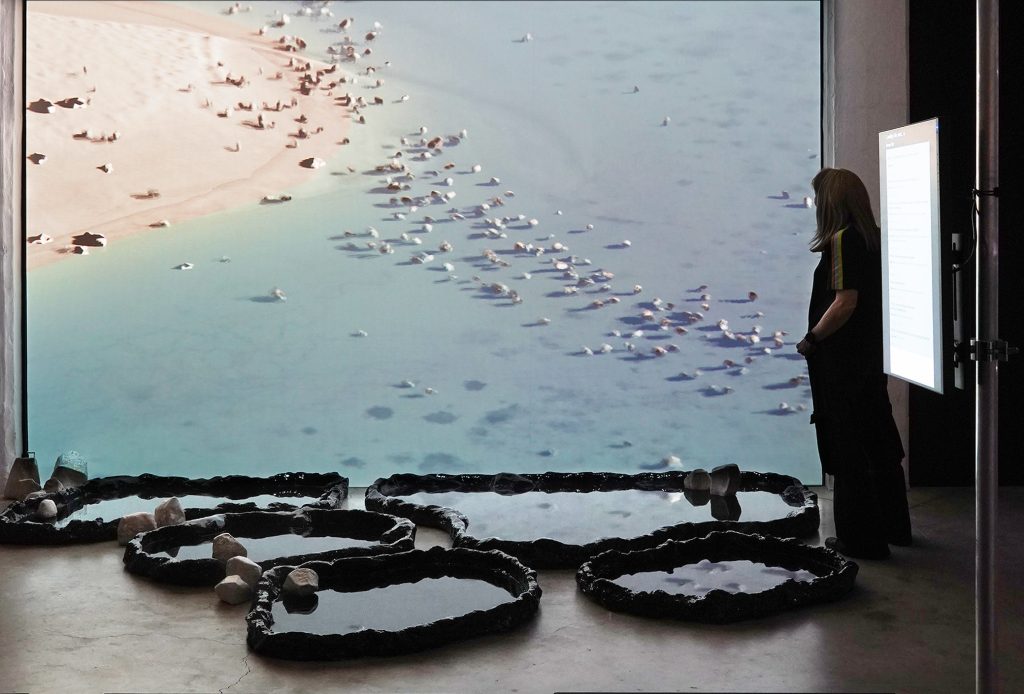
Penelope created water ponds similar to those in the Atacama Desert within the exhibition space, bridging the digital world to the physical world. Visitors were encouraged to touch the water and engage with the digital realm, becoming a part of an embodied experience. “There is a present and a future to this work with a series of access points” says Penelope. It is up to the visitor to choose how to engage, either by enjoying the meditative, immersive aesthetic of the artwork or by pondering on the future of water mining and its connection to green energy policies. It is an invitation to a multilayered process of thinking beyond dichotomies, where everyone can participate. As Penelope says, “You can’t unhear a story.”
I ask Penelope about her earlier works before she completed her Master of Fine Arts at School of Contemporary Art at University of Australia in 2016 and before she received the prestigious Fauvette Loureiro Memorial Artists award in 2018. She also holds degrees both in science and art. In fact, it was her works from 2010 that I first came to know Penelope. In these pieces, she explored the contemporary working environment and the urban living conditions, generating propositional patterns of behavior driven by neoliberal theories of work, efficiency, and the economics of disposable architecture. I was drawn to the timelessness of these work patterns reflected through humor and how relevant they still were, despite advancements in technology and shifts in communication.
Penelope explains how this series of works unfolded after she had her youngest baby and stepped out of the gaze of the artworld. She would go out and spend time filming in the street, placing her camera on the pram of her son, using it as a dolly. “A mother with a baby is like the least threatening person in the world, so I could film in all sorts of places, and no one would ever ask,” says Penelope. One of these places was an auction house where the colonial Holey Dollar coin was being sold, a symbol for one of Australia’s corporate banks, Macquarie. She became intrigued by the coin’s history and its connection to Spanish colonization, global currency sovereignty, appropriation, and extraction. “The coin was so compelling that it stood on its own as an incredibly potent symbol for economies built around extraction,” says Penelope.
Through Penelope’s planetary stories, we are offered access to that non-human point of view, one that speaks of the resilience and autonomy of the forest and other non-human inhabitants.
Penelope Cain. “Sound of Wind Through the Crystaline Forest (Think Like a Mountain II)”, 2019. Potosi Silver mine on Cerro Rico Mountain in Peru, re-imagines itself covered with the now-rare Peguena trees and a group of flags depicting an oversized galena crystal, a silver, zinc, and lead crystal, such as is found in the mineral load under the mountain. Courtesy of the artist.
At the time, she had no studio, but she had a kitchen table. “If I did not make a work on that kitchen table, it just never got made. That is why I ended up making much more video in these earlier years because I could edit and finish them the fastest.” These works later helped Penelope to receive residencies and grants. During this time, she began incorporating science-based research and fieldwork into her artistic production. She would film during the day and conduct research at night, saying that with a family, it was an easy way of doing things back then. Her work with Holey Dollar evolved into a solo exhibition at Kudos Gallery in Sydney, Australia, in 2018, titled “Dump.”
The “dump” coin was created in 1813 when Governor Lachlan Macquarie of New South Wales punched a hole in Spanish silver pesos to address the currency shortage. “This acted as a form of currency magic,” explains Penelope. The inner piece, called the “dump,” was worth less than the outer coin. It was used as a currency in the early colony, with “dump” referring to the inferior land.
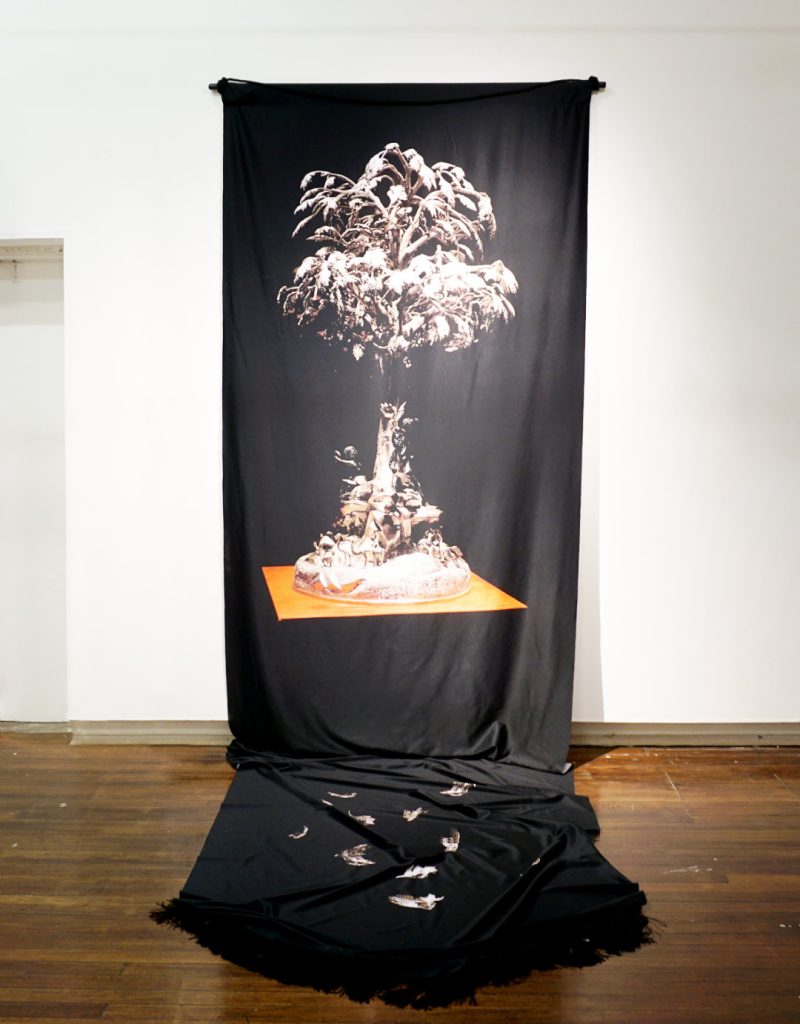
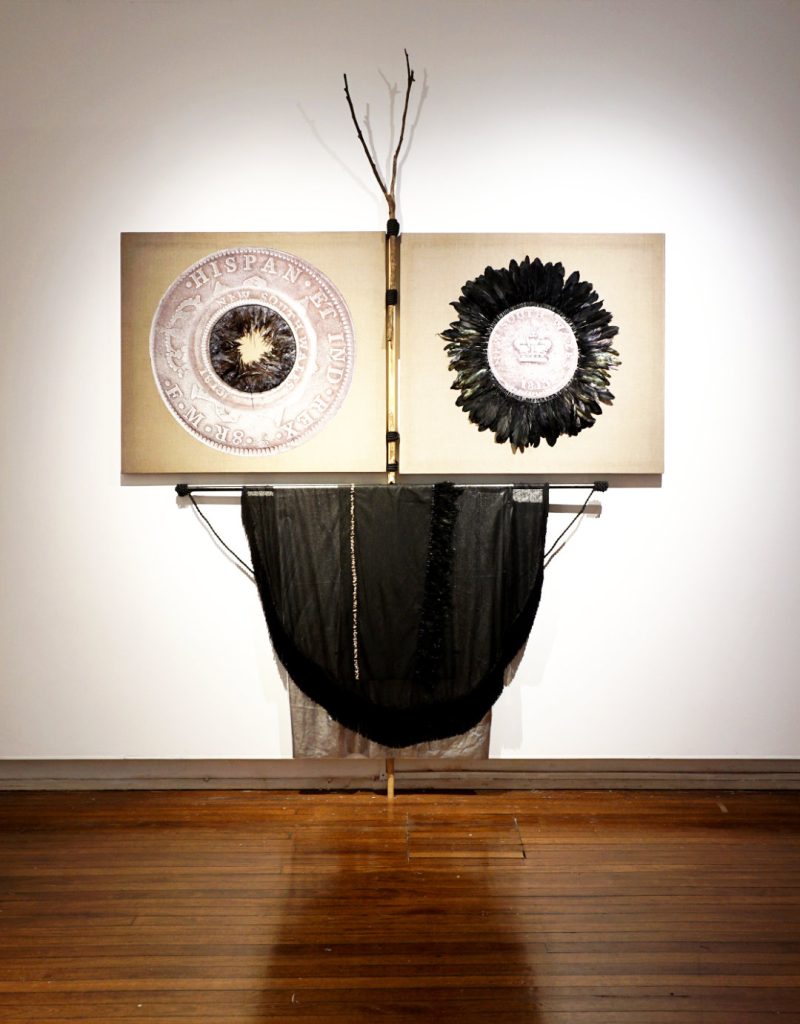
We had our final rounds of tea with Penelope in the morning at her studio, discussing how every moment matters when she is doing fieldwork and how she prepares for her encounters with scientists, out of respect both for their time as well as her own. Later that afternoon, she had a meeting with a robot maker. I left her studio and headed to Amsterdam, reflecting on the daisies that bloomed exactly 12 months after the bushfires in Australia, as a sign of forest’s rebirth and how people traveled miles to see them. It is called epicormic growth explains Penelope, the incredible ability of plants and trees to sprout new branches after damage, helping them to recover and regenerate. “A forest fit for the Anthropocene,” says Penelope, which makes me think of Anna Tsing’s proposition to consider regeneration “as the forest’s own force of life, and its own point of view”[1]. Through Penelope’s planetary stories, we are offered access to that non-human point of view, one that speaks of the resilience and autonomy of the forest and other non-human inhabitants. These stories, despite all human interventions and the presence of the Anthropocene Himself,[2] affirms the existence of non-human knowledges that we can learn from-if only we listen.
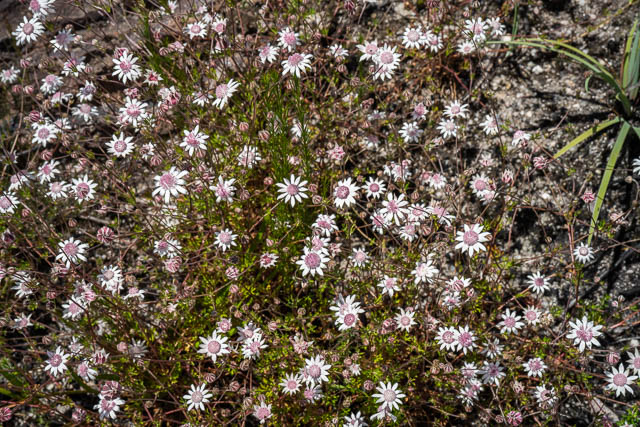
More information on Penelope’s works and research can be found here:
https://penelopecain.com/category/news/
Instagram: @penelope.cain
Vimeo Penelope Cain: https://vimeo.com/user26576636
Footnotes:
[1] Tsing, Anna, The Mushroom at the End of the World, Princeton University Press, 2015, 179-190
[2] In her essay, “Earth Stalked by Man,” Tsing writes,” manifestations of post-Enlightenment Modern Man got us into the mass we call the Anthropocene”. Tsing deliberately writes Man with capital M and Himself with the capital H in reference to the White Male, Christian Anthropocene. She writes, “He has a gender, a race, a religion, a theory of property and an idea about self: these make it possible for Him to generalize. It is difficult to generalize from a black Muslim woman; it is only possible for Him to generalize”. “Neither Man nor His Others takes responsibility; neither has a plan, I have been calling this the hidden force – the excess of the colonial encounter accounted for by neither side.” For more information, see: Anna Tsing, “Earth Stalked by Man.” Tsing, Anna “Earth Stalked by Man”, The Cambridge Journal of Anthropology, Feb 8, 2021, 2 -16
Elif Carrier
Elif Carrier is a researcher, curator, writer, and art consultant. Her work focuses on facilitating artistic productions that challenge the historical trajectory and how we act in the contemporary world, in line with her interest in the use of art within society to respond to current urgencies from decentralized positions. She holds a MAS in Curating from Zurich University of Arts and is a Ph.D. candidate in Practice in Curating at Reading University



